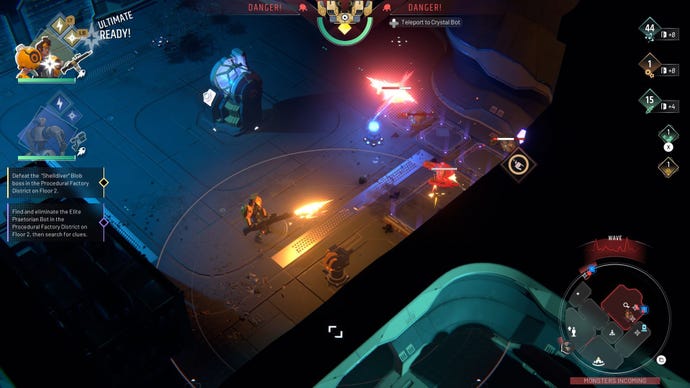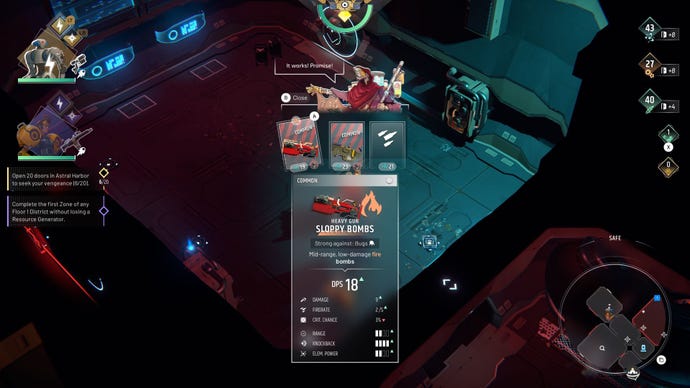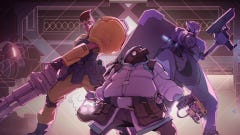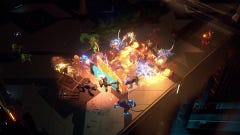Endless Dungeon review: an excellently moreish roguelike about opening doors
Door to door gunman
Let me put you at ease. Endless Dungeon is a very splashy, confidently clever roguelike about spannering turrets, hosing bullets, and popping bugs like angry little pimples. It sounds disgusting when I type it out loud like that, so let's pivot to the reliable food analogy. It is a delicious game, a hearty stew. A tasty one-more-go-er, perfectly suited to serving up in these dreary autumn months. There. Now that you've been pacified by the imagery of a steaming bowl of pleasing dungeon gumbo, you will forgive the 400 words I have written below about doors.
Before that, the basics. You play a posse of spacefolk stranded on a monolithic space station, titanic both in size and wreckishness. You want to find a way off, but the answer lies deep in the station's bowels, and inevitable death awaits. Happily, there's a device, the "reloader" which zaps your revived corpse back to a friendly saloon, complete with bar and stage band, where you spend "cells" and "scraps" on upgrades to characters and weapons, making your next delve a little easier.

A familiar loop, but the dungeon's in the detail. Each run sees you (and up to two friends in co-op, if you like) guiding a small, spidery robot, the Crystalbot, between glowing sockets as you look for a viable path through locked rooms. On the hoof you'll also build defensive turrets in the power outlets that litter the floor of each chamber. The studio behind the game established this neat formula of defensive dungeon dipping with the inversely named Dungeon of the Endless back in 2014, so this is sort of a spiritual successor. But if you missed that, just imagine escorting the mulebot from Deep Rock Galactic through a sci-fi Hades. With tower defence.
I make the comparison to everyone's favourite Greecelike because Hades-heads will probably feel at home with the combat here. The disco of attack shapes lighting up the floor, the chests allowing for mid-run weapon swaps, the post-death chit-chat with a cast of likeable misfits. Like Hades it is, at times, a "busy" game. But also a more tactical one. Decision-making during a run comes not from boon a la carte, but in deciding where to place your handy turrets before a big wave of nasty drones appears. Or more importantly, in deciding which door you will next crack open like a cold and sometimes lethal beer. Because, let me tell you, this game does the humble door absurdly well.
Opening doors gives you cash. This sounds very boring and straightforward. But it is a remarkably elegant design decision. You need cash to build turrets (and do other things) and although you can build generators to increase your earnings, you don't actually trigger those earnings until you crack open a door. This gives every single door intrinsic value, no matter how plain-looking or suspicious. A door isn't inviting thanks only to what the resulting room may contain (upgrades, loot, the zone's exit...) but also because it is a bloody door, cha-ching. Endless Dungeon takes one thing all game designers instinctively hate (doors - don't ask) and turns them into treasure chests. I love this. It means exploring is tied directly to your power in a fundamentally encouraging way.

It's not just the turrets you're saving your sci-fi cash for. On top of tech points (the currency used to build turrets) you also get food points and science points. Science bucks will unlock cool new turrets, like flamethrowers, acid guns, range amplifiers, tesla coils, and so on. You also need it to buy powerful elemental weapons (rail guns, acid peashooters) from a shady merchant. Meanwhile, food quids are dumped into upgrade consoles for character bonuses (a 10% fire rate increase, a 20% defence boost, etc). But whatever you're buying, the impetus is clear. Get opening those doors! It's not like there'll be a nest of otherworldly alien beings that can phase in and out of reality behind that big space hatch.
Oh.
Oh, I seeeeee. Do you see?
It all comes together to create a continually pleasing risk-reward bullet wander. There are a few quirks of the genre, of course. For example, as the maps get more complex, much of the eyegame is played looking at your radar, since it is so valuable for tracking incoming packs of baddies. In a way this suits the combat. An Aliens-style motion detector showing swarms of red dots approaching is pretty much expected for this type of setting. But it can be distracting to realise you are focusing on a cleaner version of the exact game you are already playing, scrunched into a small circle in the corner of your screen.
This is extra noticeable during "blackouts", moments of sudden power loss where all your turrets go down and you have to find some computer terminals to restore power. In blackouts, enemies steadily trickle out of their hidey holes, rather than swarming out in full-blown waves. And they don't appear on radar in dark rooms until you can already see them directly. Yet the need to quickly find the right light-restoring Macbook Pros has you looking predominantly at the radar. As an intentional moment of heightened tension, it really works. But I also sometimes groan when it happens (sometimes multiple times on the same floor...) because it feels like an interruption to the door-by-door exploring and blasting, which I simply like too much to want to stop.




It's a small complaint. Plenty more fun problems come to pee on your power-up parade. Dark rooms need to be powered with a special resource, "Dust", before you can place turrets inside. Strategically cursed corridor formations can randomly appear, causing you to rethink the best place to bottleneck enemies. Monoliths that buff monsters show up and demand a tithe to deactivate. Big roly poly bugs roll off to hidden corners to spawn other monsters endlessly until you go deal with them. It all builds on top of that central door-cracking premise in a very neat and balanced way.
Some floors culminate in boss battles where you have to shepherd your Crystalbot out of the boss's brutal attack splashes, like some pet spider with no survival instinct, all the while repair-donking your turrets, traps, and gizmos in the arena. At the same time dozens of regular enemies will spawn and nibble at both you and your precious robo pet. In a lesser game this would easily feel like babysitting an egg during an earthquake in a warzone. But the Crystalbot is often the key to defeating said bosses, whether that's as simple as ordering it to drill a hole in the skull of an incapacitated tentacled beast, or plugging it into infected terminals to administer cyber antibiotics to a horrendous rogue AI. It feels like Crystalbot is part of the squad.
And it's a nice squad. Characters fall broadly into two big flavours: heavy weapons murderer and handgun-sporting supportbud. My favourite is the angry Marxist engineer, "Comrade", who has his own stash of personal mini-turrets, or perhaps "Blaze", the four-armed robot cowboy with a pocket full of proximity mines. There's definitely enough variety in abilities to allow for good multiplayer synynynynergizing (sadly I didn't get to try out the multiplayer, but if you like the twin-stick buddying-up of Helldivers, you'll likely go ham for this). You can unlock all eight characters easily within ten hours, but they all have personal missions to fulfil that take many more dives into the spacehells that reward them with extra buff slots.

There's other things I appreciate. The laser sight very subtly snaps to viable targets. The sci-fi lore is there in spades but is genially non-invasive (playable characters often react with comical disinterest when reading lore diaries, saying "yada yada!" or "too much to keep track of"). Aside from a few zealous blackouts and enemies sometimes getting stuck, I've found absurdly little to dislike in the rampaging goodtimes of it all. I still haven't made my way into the deepest endguts of the space dungeon, though. Maybe there's a 20-minute unskippable cutscene down there. But going by the level of polish everywhere else, I doubt it.
So aye. Like any stew, there's a lot piled in. But the principle ingredients are filling and simple. Endless Dungeon's core design, if we want to break it right down, is made of the following stuffs: turret, door, nest, money. There is nothing in these elements, or even in the "verbs" of the game, to make it unique. Hundreds of games use the same ingredients, even aim for the same taste (lighthearted Aliens). But Amplitude's recipe here, their choice of spices, results in a uniquely pleasing dish. They sprinkle the turrets, they keep the nests chunky, they bake the money into the doors. (God, I'm hungry.) The result is an absolutely stacked dish that roguelike-likers will be very happy to gorge on.
This review is based on a review build of the game provided by publishers Sega.













